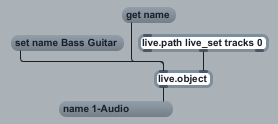Examples

Perform operations on Live objects
| Name | Description |
|---|---|
| Left inlet | Gets all command messages described below. |
| Right inlet | Gets object id message to select the object to operate upon. means no object, i.e. all messages to the left inlet are ignored, which is also the initial state. |
| Name | Description |
|---|---|
| Left outlet | Sends responses to , , , , , and . |
| get | property [symbol] |
Arguments: the name of a single-value property of the current object Operation: Sends value of given property of the current object.
|
||||||
| get | list-property [symbol] |
Arguments: the name of a list property of the current object Operation: Sends the list of values of given property of the current object.
|
||||||
| get | child [symbol] |
Arguments: the name of a child of the current object Operation: Sends the id of the child of the current object.
|
||||||
| get | list-child [symbol] |
Arguments: the name of a list-child of the current object Operation: Sends the ids of the elements of the list-child of the current object.
|
||||||
| set |
property [symbol] value [various types] |
Arguments: the name of a single-value property of the current object the new value for the property Operation: Sets the value of given property of the current object. Remark: Not all properties can be set. The types of the properties are given in the Live Object Model. - no output - |
||||||
| set |
list-property [symbol] value-list [various types] |
Arguments: the name of a list property of the current object the new values for the property Operation: Sets the given list property to the value list. Remark: Not all properties can be set. The types of the properties are given in the Live Object Model. - no output - |
||||||
| set |
child [symbol] id nn [id] |
Arguments: the name of a child of the current object the new child object for this name Operation: Sets the child name to point to the given child. Remark: Not all children can be set. - no output - |
||||||
| set |
list-child [symbol] id nn ... id mm [id-list] |
Arguments: the name of a list child of the current object the new list of objects for the given name Operation: Sets the list child to contain the given ids. Remark: Not all children can be set. - no output - |
||||||
| call |
function [symbol] parameter-list [list of different types] |
Arguments: function the name of the function an optional list of parameters Operation: Calls the given function of the current object, optionally with a list of parameters. Remark: The types of the parameters are given in the Live Object Model.
|
||||||
| bang, getid | Operation: Sends the id of the current Live object to the outlet.
|
|||||||
| getinfo | Operation: Sends a description of the current object. Output to left outlet (most lines may occur multiple times, last line is ): Example output: |
|||||||
| gettype | Operation: Sends the type (a.k.a. class) of the current object.
|
|||||||
| getpath | Operation: Sends the canonical path of current object.
|
|||||||
| id nn | Operation: Sets the current object. The message has the same effect if sent to both the right or the left inlet. For clarity it is suggested to always use the right inlet to supply the object id. - no output - |

| Name | Description |
|---|---|
| Live API Overview | |
| Live Object Model | |
| live.path | Navigate to objects in the Live application |
| live.observer | Monitor changes in Live objects |
| live.remote~ | Realtime control of device parameters |
| Using the Live API | Creating Devices that use the Live API |
| The LiveAPI JavaScript Object (jsliveapi) | The LiveAPI Object |